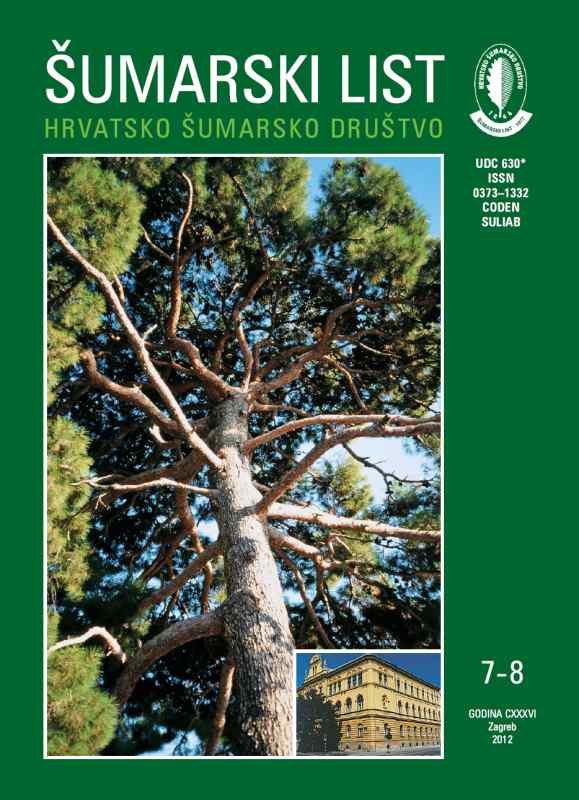
broj: 7-8/2012
pdf (5,5 MB) |
|
||||||||||||||
| RIJEČ UREDNIŠTVA | ||
| Uredništvo | ||
| SOMETHING ABOUT RESTRUCTURING pdf HR EN | 329 | |
| IZVORNI ZNANSTVENI ČLANCI | ||
| Krunoslav Teslak, Jura Čavlović, Mario Božić | UDK 630*624+653 (Pedunculate oak) (001) | |
| The even-aged forest development computer program SIMPLAG: design, structure and application pdf HR EN | 331 | |
| Milan Pernek, Sanja Novak Agbaba, Nikola Lacković, Nikolina Đođ, Ivan Lukić, Stefan Wirth | UDK 630* 165 (001) | |
| The role of biotic factors on pine (Pinus spp.) decline in north Dalmatia pdf HR EN | 343 | |
| Damir Drvodelić, Milan Oršanić, Zoran Zeman | UDK 630*233+232.3 (Pyrus pyraster Burgsd.) (001) | |
| Field performance after reforestation with one year old non-transplanted (1+0) and transplanted (1+1) seedlings of wild pear (Pyrus pyraster Burgsd.) pdf HR EN | 355 | |
| Dinka Matošević, George Melika | UDK 630*442 (001) | |
| Diversity of parasitoid assemblages of native and alien leaf miners in Croatia pdf HR EN | 367 | |
| SUMMARY Leaf miners support rich parasitoid assemblages and majority of these parasitoid species are generalists. Alien and invasive species are global problem and pose direct and indirect threat to ecosystem stability. Leafminers are very successfull invaders and they build up their populations soon after establishment in an new area. Invaders escape from their native parasitoids and have competitive advantage over native species in new area. Native parasitoids adapt to new host and new parasitoid assemblages are established. Croatia has rich native leafminer fauna with recently added alien and invasive species. Phyllonorycter roboris, Phyllonorycter quercifoliella, Tischeria ekebladella on Quercus robur and Q. petraea, Phyllonorycter klemannella on Alnus glutinosa are native leafminers. Phyllonorycter robiniella, Parectopa robinella on Robinia pseudoacacia, Phyllonorycter platani on Platanus sp., Cameraria ohridella on Aesculus hippocastanum and Phyllonorycter leucographella on Pyracantha coccinea are recently introduced invasive species in Croatia. In this research we tested the following hypotheses: a) native parasitoids have adapted to new hosts, b) these parasitoid species are generalists, c) native and alien species of leafminers with similar bioecological characteristics have similar parasitoid assemblages. The sites of research were chosen according to the host plant sites, in forests and parks in Croatia. The research was carried out from 2004–2006. Leaves with mines were collected and kept in glass containers in outside insectary until emergence of parasitoids. For each parasitoid assemblage the diversity indices were calculated: Domination index (D), Shannon’s diversity index H and evenness of species E. Cluster analyses for comparison of similarities of parasitoid assemblages was done. In total, 28 taxa of parasitoids from the superfamily Chalcidoidea and 4 taxa from the superfamily of Ichneumonoidea have been found (Table 1). Table 1 shows domination index (D) for parasitoid species found for a host leaf miner. This research compares the parasitoid assemblages of different species of leafminers, the results have been obtained after mass rearings of parasitoids from different localities and different collection times and it does not give detailed insight into parasitism percentages and the seasonal distribution of parasitoid species within a parasitoid assemblage. Table 2 shows values of Shannon’s diversity index H and evenness of species E, and Figure 1 shows dendrogram from cluster analyses grouping leaf miner species according to the similarities of their parasitoid assemblages. The majority of parasitoid species found are generalist species found on other species of leaf miners from the order Lepidoptera. P. roboris/P. quercifoliella have the most diverse parasitoid assemblage (the highest H value) (Table 2) followed by T. ekebladella. Oaks support rich fauna of taxonomicaly and ecologicaly similar leaf miner species and free exchange of parasitoids is enabled among them. All the parasitoid species found on these leafminers are generalist. They also have the highest E value (Table 2) because they lack specific monophagous parasitoid species. P. klemannella has lower diversity indices H and E because of the dominance of specific parasitoids from Encyrtidae family. P. platani has two dominant parasitoid species Minotetrastichus platanellus and Pediobius saulius. Dendrogram shows that P. roboris/P. quercifoliella, P. robiniella, P. leucographella, Pa. robiniella i T. ekebladella have similar parasitoid assemblages. Very similar are T. ekebladella and Pa. robiniella, both host species grow on the same sites together (oak and black locust) and generalists can search for similar mines: white upper surface leaf mines. The greater linkage distance between P. klemannella i P. platani can be explained with the dominance of specific monophagous parasitoid species in the assemblage. The similarities between parasitoid assemblages of native (P. roboris/P. quercifoliella, T. ekebladella) and alien (P. leucographella, P. robiniella, Pa. robiniella, C. ohridella) leaf miner species show that the native generalist parasitoids have adapted to new hosts. Ten species of parasitoids have been found on C. ohridella, with Pediobius saulius and Minotetrastichus frontalis as two dominant species (Table 1). This research has shown that invasive leaf miner species in Croatia have recruited a parasitoid community similar to the native leaf miner species and that this process has occurred quite rapidly. Key words: Tischeria ekebladella; Parectopa robinella; Cameraria ohridella; Phyllonorycter sp.; diversity indices; polyphagous parasitoids; adaptation; new host | ||
| STRUČNI ČLANCI | ||
| Marija Nodilo | UDK 630*165+907 | |
| Natural heritage of the island of Mljet – the basis of the development of the medical tourism pdf HR EN | 377 | |


